Application of Optimal Energy Management Strategies for a Building Powered by PV/Battery System in Corsica Island
Abstract
1. Introduction
- Energy storage systems;
- Smart electrical grid with an optimization of the energy and power management;
- Forecasting methods for renewable production and user consumption.
2. Materials and Methods
2.1. Objectives
- A presentation of the existing microgrid with PV generation and storage in the R&D platform PAGLIA ORBA in Ajaccio, Corsica (FRANCE) and of the load to supply;
- The electricity tariffs in France and the specific assumptions for the Corsican situation;
- The various EMS strategies with or without a forecasting of production;
- The results and a comparison in term of energy and cost savings;
- The perspectives for future works.
2.2. Presentation of the Microgrid
- 3 DGs: 3 × 17 kW (AC) of PV;
- 1 ES: 24 × 2 V lead–acid batteries for a total capacity of 70 kWh (DC);
- 2 loads: An accommodation and an electric vehicle.
2.3. Profiles Presentation and Electricity Price Variation
- Electricity supply with production cost and commercialization: 42.0 + 11.5 = 53.5 €;
- Electricity transmission: 44.0 €;
- Taxes: Various French taxes: 48.5 €.
2.4. Energy Management Strategies
2.4.1. Linear Programing Optimization
2.4.2. Rule-Based Control Strategies
A. RBC1
- : The load is supplied by PV power. After satisfying the load requirement, the surplus is used to charge the battery up to its SoC maximum level. When the battery is fully charged, surplus is sold in the grid. If is zero, PV only supplies the load, while the battery and grid are not used.
- The PV power does not meet the load. As far as possible, the missing power is supplied by the battery. When the battery power is not sufficient to supply the load, the grid is used to add the remaining power.
B. RBC2
- : PV supplies the load and surplus is used to charge the battery. When the battery is fully charged, the surplus is sold in the grid. If is zero, PV only supplies the load, while the battery and grid are not used.
- : After supplying the load, is sold in the grid and the surplus is used to charge the battery.
- and t ∊ [22:00–4:00]: The load is only supplied by the grid because at this time, and the energy cost is low (off-peak hours).
- and t ∊ [4:00–5:00] and (SoC ): The battery is discharged at until its SoC reaches 50% to supply the load and the surplus is sold in the grid. This allows the battery to store more PV during the day.
- and t ∊ [4:00–5:00] and (SoC ): If the battery SoC is low at the beginning of peak hours, the case is the same as next bullet.
- and t ∊ [5:00–22:00]: PV power does not have the capacity to fully supply the load. The remaining power is provided in priority by the battery and then by the grid.
C. RBC3
- and : The load is only supplied by PV and the surplus is sold in the grid.
- : The load is only supplied by PV and the surplus is used to charge the battery. When the battery is fully charged, the surplus is sold in the grid.
- : After supplying the load, is sold in the grid and the surplus is used to charge the battery.
3. Results
3.1. LP Optimization and RBC Strategies Results
- The battery never reached its minimum capacity during this period;
- A period of three successive days of battery discharge appears;
- The power limitation of 24 kW from and to the grid is reached several times during this period, showing the importance of the battery to provide or absorb the complementary power;
- The battery SoC behavior has a very similar profile during the days with important PV production (clear sky days);
- The plateau which appears every day on the SoC curve after 22:00 and until 4:00 comes from the electricity tariff change due to the transition from off-peak and peak hours. At this moment, it is more “cost-effective” to use the electricity provided by the electrical grid rather than from the battery;
- Similarly, when the tariff changes from off-peak to peak hours (at 4:00) the SoC decreases because the utilization of the battery becomes more interesting.
3.1.1. RBC1
3.1.2. RBC2
3.1.3. RBC3
3.2. Main Results Discussion
- An important improvement in terms of saved cost is obtained by switching from RBC2 to RBC3 (87.8% to 94.9%) thanks to the implementation of PV forecasting.
- Comparison between RBC3 and RBC3r shows that the gain obtained with perfect forecasting is not significant (94.9% to 97.3%) compared to a standard ARMA model and considering that PV data have been averaged on a 6 h period.
- The share of the PV production which is lost (due to full storage, PV power limitation sent to the grid or charge power limitation) decreases with each strategy improvement.
3.3. Corrected Tariffs Results
4. Conclusions
- Assessment of the grid power limitation for network service (peak power shaving, guaranteed power, etc.).
- Development of new energy management strategies such as MILP to take into account more constraints (load management).
- Implementation and test of selected strategies in real operating conditions on PAGLIA ORBA microgrid.
- Improvements of the cost calculation by including CAPEX and OPEX of the system.
Author Contributions
Funding
Conflicts of Interest
Nomenclature
| ARMA | Auto Regressive Mobile Average |
| CAPEX | Capital Expense |
| DG | Distributed Generation |
| DoD | Depth of Discharge |
| ES | Energy Storage |
| EMS | Energy Management System |
| EV | Electric Vehicle |
| LP | Linear Programing |
| MILP | Mixed Integer Linear Programing |
| MPC | Model Predictive Control |
| nRMSE | normalized Root Mean Squared Error |
| OPEX | Operating Expense |
| PV | Photovoltaic |
| RBC | Rule Based Control |
| SoC | State of Charge |
| V2G | Vehicle to Grid |
| V2H | Vehicle to Home |
| PV power | |
| Load power | |
| Grid power | |
| Degraded PV power | |
| Missing power | |
| PV power to load | |
| PV power to battery | |
| PV power to grid | |
| Battery power to load | |
| Battery power to grid | |
| Grid power to load | |
| Energy buying price | |
| Energy selling price | |
| PV array nominal power | |
| Inverter maximum power | |
| Grid maximum power output | |
| Grid maximum power input | |
| Battery maximum power input | |
| Battery maximum power output | |
| Battery admissible power input | |
| Battery admissible power output | |
| Battery useful capacity | |
| Battery charge efficiency | |
| Battery discharge efficiency |
References
- IEA PVPS Task 1 Strategic PV Analysis and Outreach. Available online: https://www.comitesolar.cl/wp-content/uploads/2020/04/IEA_PVPS_Snapshot_2020-2.pdf (accessed on 28 August 2020).
- Jäger-Waldau, A. Snapshot of Photovoltaics—February 2020. Energies 2020, 13, 930. [Google Scholar] [CrossRef]
- Lara-Fanego, V.; Ruiz-Arias, J.A.; Pozo-Vázquez, D.; Santos-Alamillos, F.J.; Tovar-Pescador, J. Evaluation of the WRF model solar irradiance forecasts in Andalusia (southern Spain). Solar Energy 2012, 86, 2200–2217. [Google Scholar] [CrossRef]
- Espinar, B.; Aznarte, J.-L.; Girard, R.; Moussa, A.M.; Kariniotakis, G. Photovoltaic Forecasting: A State of the Art; OTTI—Ostbayerisches Technologie-Transfer-Institut: Tarragona, Spain, 2010; pp. 250–255. ISBN 978-3-941785-15-1. [Google Scholar]
- Robert, G.; Philip, H.; Dennis, A.; Tim, G.; Matthew, L.; Jim, S. The Costs and Impacts of Intermittency: An Assessment of the Evidence on the Costs and Impacts of Intermittent Generation on the British Electricity Network; UK Energy Research Centre: London, UK, 2006. [Google Scholar]
- Notton, G. Importance of islands in renewable energy production and storage: The situation of the French islands. Renew. Sustain. Energy Rev. 2015, 47, 260–269. [Google Scholar] [CrossRef]
- Destro, N.; Benato, A.; Stoppato, A.; Mirandola, A. Components design and daily operation optimization of a hybrid system with energy storages. Energy 2016, 117, 569–577. [Google Scholar] [CrossRef]
- Cooper, M. Renewable and distributed resources in a post-Paris low carbon future: The key role and political economy of sustainable electricity. Energy Res. Soc. Sci. 2016, 19, 66–93. [Google Scholar] [CrossRef]
- Yeatts, D.E.; Auden, D.; Cooksey, C.; Chen, C.-F. A systematic review of strategies for overcoming the barriers to energy-efficient technologies in buildings. Energy Res. Soc. Sci. 2017, 32, 76–85. [Google Scholar] [CrossRef]
- Sartori, I.; Napolitano, A.; Voss, K. Net zero energy buildings: A consistent definition framework. Energy Build. 2012, 48, 220–232. [Google Scholar] [CrossRef]
- Langbroek, J.H.M.; Franklin, J.P.; Susilo, Y.O. When do you charge your electric vehicle? A stated adaptation approach. Energy Policy 2017, 108, 565–573. [Google Scholar] [CrossRef]
- Cao, C.; Wu, Z.; Chen, B. Electric Vehicle—Grid Integration with Voltage Regulation in Radial Distribution Networks. Energies 2020, 13, 1802. [Google Scholar] [CrossRef]
- Marczinkowski, H.M.; Østergaard, P.A. Residential versus communal combination of photovoltaic and battery in smart energy systems. Energy 2018, 152, 466–475. [Google Scholar] [CrossRef]
- Luo, F.; Ranzi, G.; Wang, S.; Dong, Z.Y. Hierarchical Energy Management System for Home Microgrids. IEEE Trans. Smart Grid 2019, 10, 5536–5546. [Google Scholar] [CrossRef]
- Zheng, M. Smart Households: Economics and Emission Impacts of Distributed Energy Storage for Residential Sector Demand Response; Columbia University: New York, NY, USA, 2015. [Google Scholar]
- Zhao, Z.; Lee, W.C.; Shin, Y.; Song, K. An Optimal Power Scheduling Method for Demand Response in Home Energy Management System. IEEE Trans. Smart Grid 2013, 4, 1391–1400. [Google Scholar] [CrossRef]
- Pedrasa, M.A.A.; Spooner, T.D.; MacGill, I.F. Coordinated Scheduling of Residential Distributed Energy Resources to Optimize Smart Home Energy Services. IEEE Trans. Smart Grid 2010, 1, 134–143. [Google Scholar] [CrossRef]
- Ozturk, Y.; Senthilkumar, D.; Kumar, S.; Lee, G. An Intelligent Home Energy Management System to Improve Demand Response. IEEE Trans. Smart Grid 2013, 4, 694–701. [Google Scholar] [CrossRef]
- Chen, X.; Wei, T.; Hu, S. Uncertainty-Aware Household Appliance Scheduling Considering Dynamic Electricity Pricing in Smart Home. IEEE Trans. Smart Grid 2013, 4, 932–941. [Google Scholar] [CrossRef]
- Missaoui, R.; Joumaa, H.; Ploix, S.; Bacha, S. Managing energy Smart Homes according to energy prices: Analysis of a Building Energy Management System. Energy Build. 2014, 71, 155–167. [Google Scholar] [CrossRef]
- Iwafune, Y.; Ikegami, T.; Fonseca, J.G.d.S.; Oozeki, T.; Ogimoto, K. Cooperative home energy management using batteries for a photovoltaic system considering the diversity of households. Energy Convers. Manag. 2015, 96, 322–329. [Google Scholar] [CrossRef]
- Erdinc, O. Economic impacts of small-scale own generating and storage units, and electric vehicles under different demand response strategies for smart households. Appl. Energy 2014, 126, 142–150. [Google Scholar] [CrossRef]
- Wu, X.; Hu, X.; Moura, S.; Yin, X.; Pickert, V. Stochastic control of smart home energy management with plug-in electric vehicle battery energy storage and photovoltaic array. J. Power Sources 2016, 333, 203–212. [Google Scholar] [CrossRef]
- Wu, X.; Hu, X.; Teng, Y.; Qian, S.; Cheng, R. Optimal integration of a hybrid solar-battery power source into smart home nanogrid with plug-in electric vehicle. J. Power Sources 2017, 363, 277–283. [Google Scholar] [CrossRef]
- Li, B.; Roche, R.; Miraoui, A. Microgrid sizing with combined evolutionary algorithm and MILP unit commitment. Appl. Energy 2017, 188, 547–562. [Google Scholar] [CrossRef]
- Bruni, G.; Cordiner, S.; Mulone, V.; Sinisi, V.; Spagnolo, F. Energy management in a domestic microgrid by means of model predictive controllers. Energy 2016, 108, 119–131. [Google Scholar] [CrossRef]
- Carli, R.; Dotoli, M.; Jantzen, J.; Kristensen, M.; Ben Othman, S. Energy scheduling of a smart microgrid with shared photovoltaic panels and storage: The case of the Ballen marina in Samsø. Energy 2020, 198, 117188. [Google Scholar] [CrossRef]
- Villalón, A.; Rivera, M.; Salgueiro, Y.; Muñoz, J.; Dragičević, T.; Blaabjerg, F. Predictive Control for Microgrid Applications: A Review Study. Energies 2020, 13, 2454. [Google Scholar] [CrossRef]
- Zia, M.F.; Elbouchikhi, E.; Benbouzid, M. Microgrids energy management systems: A critical review on methods, solutions, and prospects. Appl. Energy 2018, 222, 1033–1055. [Google Scholar] [CrossRef]
- Sharma, A.; Kolhe, M. Techno-economic evaluation of PV based institutional smart micro-grid under energy pricing dynamics. J. Clean. Prod. 2020, 264, 121486. [Google Scholar] [CrossRef]
- Wang, Y.; Huang, Y.; Wang, Y.; Zeng, M.; Li, F.; Wang, Y.; Zhang, Y. Energy management of smart micro-grid with response loads and distributed generation considering demand response. J. Clean. Prod. 2018, 197, 1069–1083. [Google Scholar] [CrossRef]
- Khorasany, M.; Azuatalam, D.; Glasgow, R.; Liebman, A.; Razzaghi, R. Transactive Energy Market for Energy Management in Microgrids: The Monash Microgrid Case Study. Energies 2020, 13, 2010. [Google Scholar] [CrossRef]
- Zethmayr, J.; Kolata, D. The costs and benefits of real-time pricing: An empirical investigation into consumer bills using hourly energy data and prices. Electr. J. 2018, 31, 50–57. [Google Scholar] [CrossRef]
- Cai, J.; Zhang, H.; Jin, X. Aging-aware predictive control of PV-battery assets in buildings. Appl. Energy 2019, 236, 478–488. [Google Scholar] [CrossRef]
- Zia, M.F.; Elbouchikhi, E.; Benbouzid, M. Optimal operational planning of scalable DC microgrid with demand response, islanding, and battery degradation cost considerations. Appl. Energy 2019, 237, 695–707. [Google Scholar] [CrossRef]
- Mahmud, K.; Town, G.E.; Morsalin, S.; Hossain, M.J. Integration of electric vehicles and management in the internet of energy. Renew. Sustain. Energy Rev. 2018, 82, 4179–4203. [Google Scholar] [CrossRef]
- Onishi, V.C.; Antunes, C.H.; Trovão, J.P.F. Optimal Energy and Reserve Market Management in Renewable Microgrid-PEVs Parking Lot Systems: V2G, Demand Response and Sustainability Costs. Energies 2020, 13, 1884. [Google Scholar] [CrossRef]
- Hu, J.; Morais, H.; Sousa, T.; Lind, M. Electric vehicle fleet management in smart grids: A review of services, optimization and control aspects. Renew. Sustain. Energy Rev. 2016, 56, 1207–1226. [Google Scholar] [CrossRef]
- Yang, Z.; Li, K.; Foley, A. Computational scheduling methods for integrating plug-in electric vehicles with power systems: A review. Renew. Sustain. Energy Rev. 2015, 51, 396–416. [Google Scholar] [CrossRef]
- Azadfar, E.; Sreeram, V.; Harries, D. The investigation of the major factors influencing plug-in electric vehicle driving patterns and charging behaviour. Renew. Sustain. Energy Rev. 2015, 42, 1065–1076. [Google Scholar] [CrossRef]
- Tascikaraoglu, A. Evaluation of spatio-temporal forecasting methods in various smart city applications. Renew. Sustain. Energy Rev. 2018, 82, 424–435. [Google Scholar] [CrossRef]
- García-Villalobos, J.; Zamora, I.; San Martín, J.I.; Asensio, F.J.; Aperribay, V. Plug-in electric vehicles in electric distribution networks: A review of smart charging approaches. Renew. Sustain. Energy Rev. 2014, 38, 717–731. [Google Scholar] [CrossRef]
- Kyriakopoulos, G.L.; Arabatzis, G. Electrical energy storage systems in electricity generation: Energy policies, innovative technologies, and regulatory regimes. Renew. Sustain. Energy Rev. 2016, 56, 1044–1067. [Google Scholar] [CrossRef]
- Ioannidis, A.; Chalvatzis, K.J.; Li, X.; Notton, G.; Stephanides, P. The case for islands’ energy vulnerability: Electricity supply diversity in 44 global islands. Renew. Energy 2019, 143, 440–452. [Google Scholar] [CrossRef]
- Notton, G.; Duchaud, J.L.; Nivet, M.L.; Voyant, C.; Chalvatzis, K.; Fouilloy, A. The electrical energy situation of French islands and focus on the Corsican situation. Renew. Energy 2019, 135, 1157–1165. [Google Scholar] [CrossRef]
- CRE. The Contribution of the Public Service of Electricity (CSPE): Mechanism, Historic and Prospective. Available online: https://www.cre.fr/ (accessed on 23 July 2020).
- OIE. Les Prix de l’électricité en France: Évolutions Passées et Perspectives. Available online: https://observatoire-electricite.fr/ (accessed on 22 July 2020).
- De Gooijer, J.G.; Hyndman, R.J. 25 years of time series forecasting. Int. J. Forecast. 2006, 22, 443–473. [Google Scholar] [CrossRef]
- Fouilloy, A.; Voyant, C.; Notton, G.; Motte, F.; Paoli, C.; Nivet, M.-L.; Guillot, E.; Duchaud, J.-L. Solar irradiation prediction with machine learning: Forecasting models selection method depending on weather variability. Energy 2018, 165, 620–629. [Google Scholar] [CrossRef]
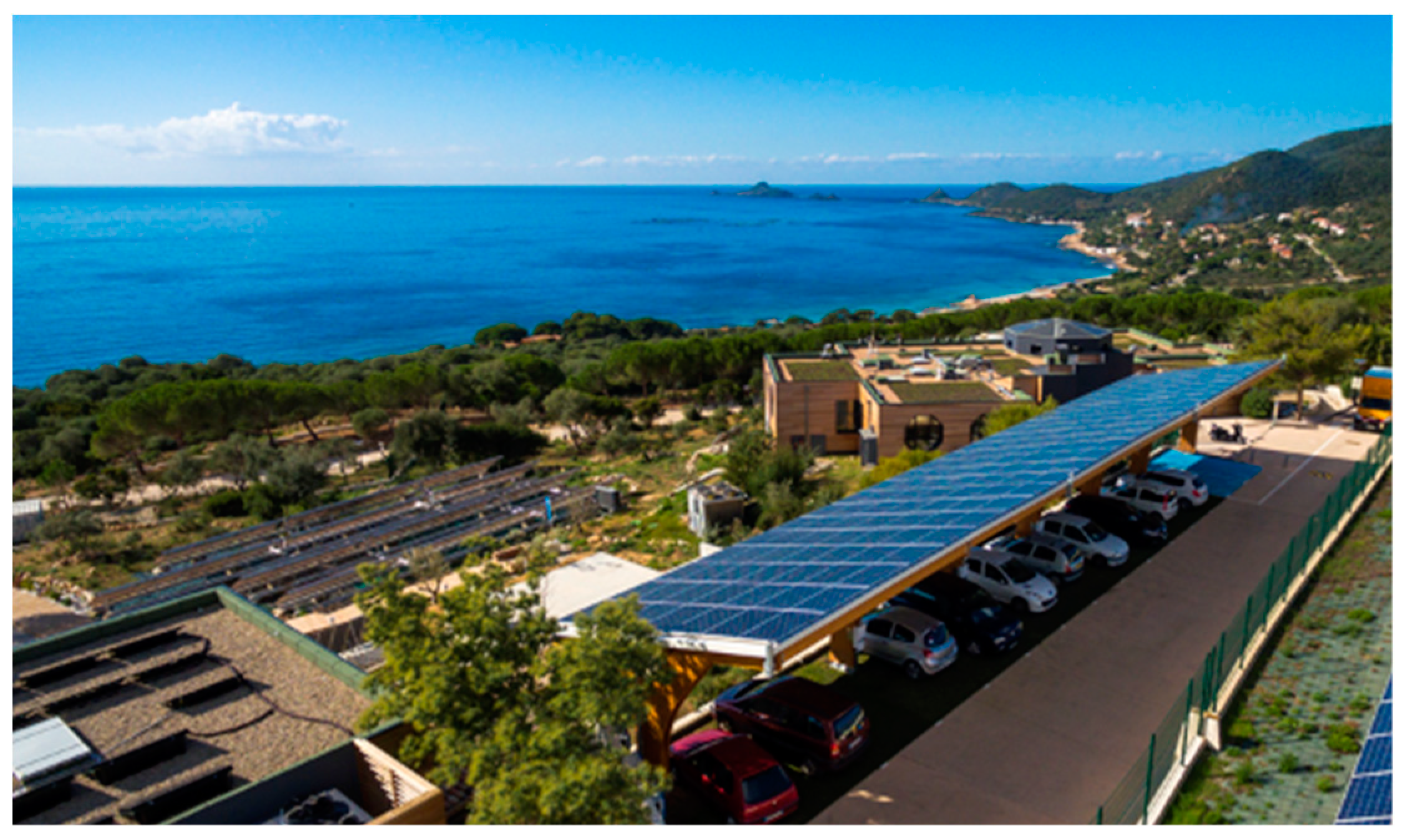
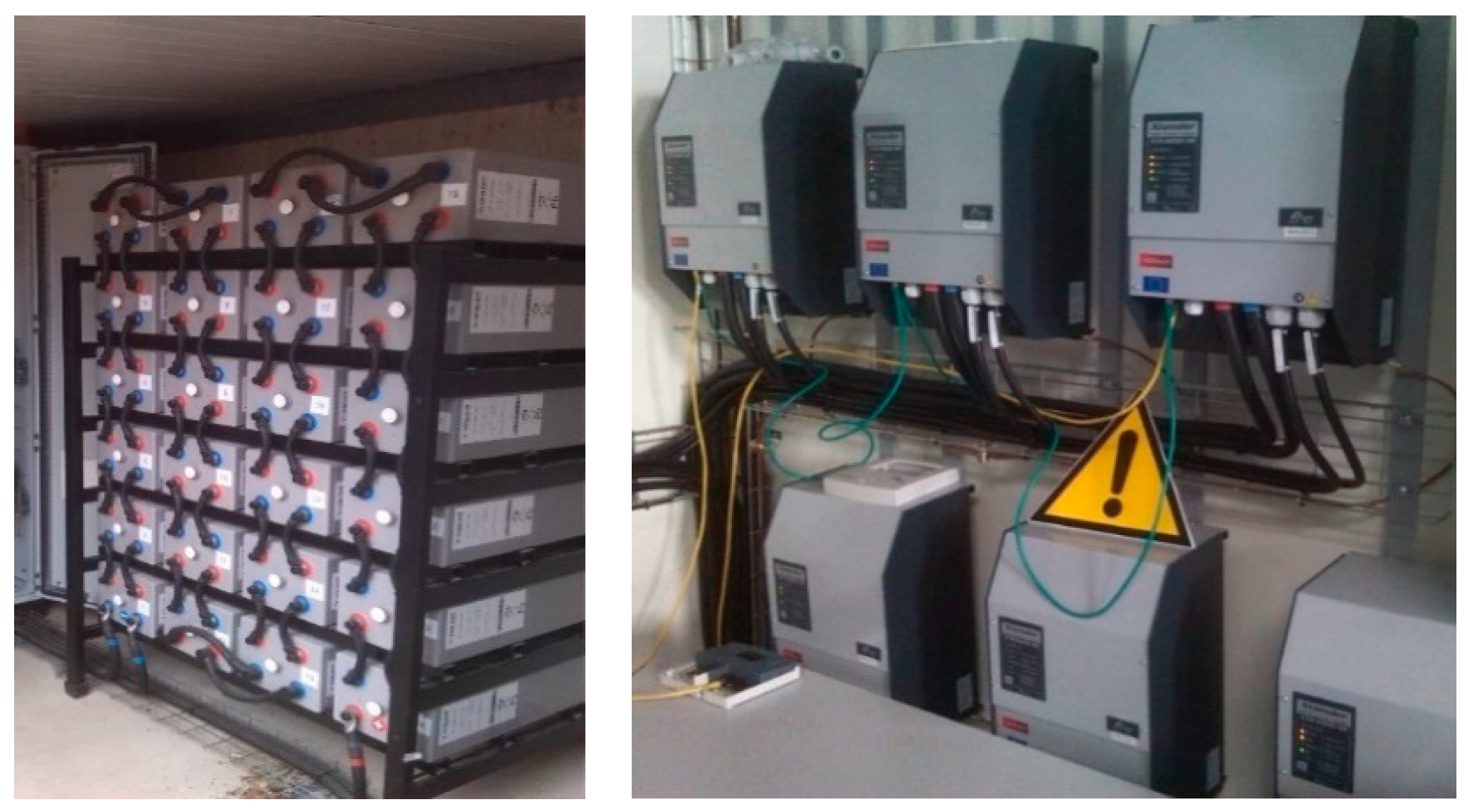
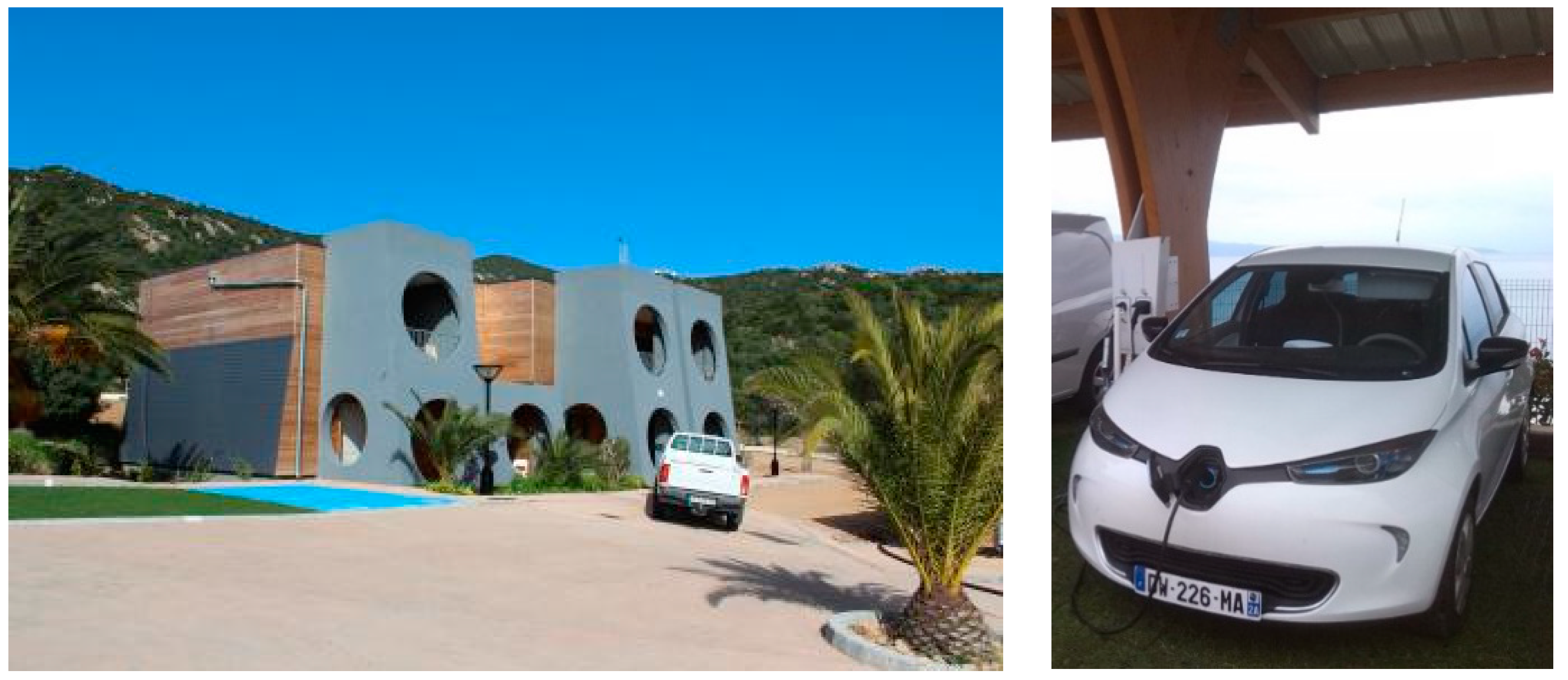
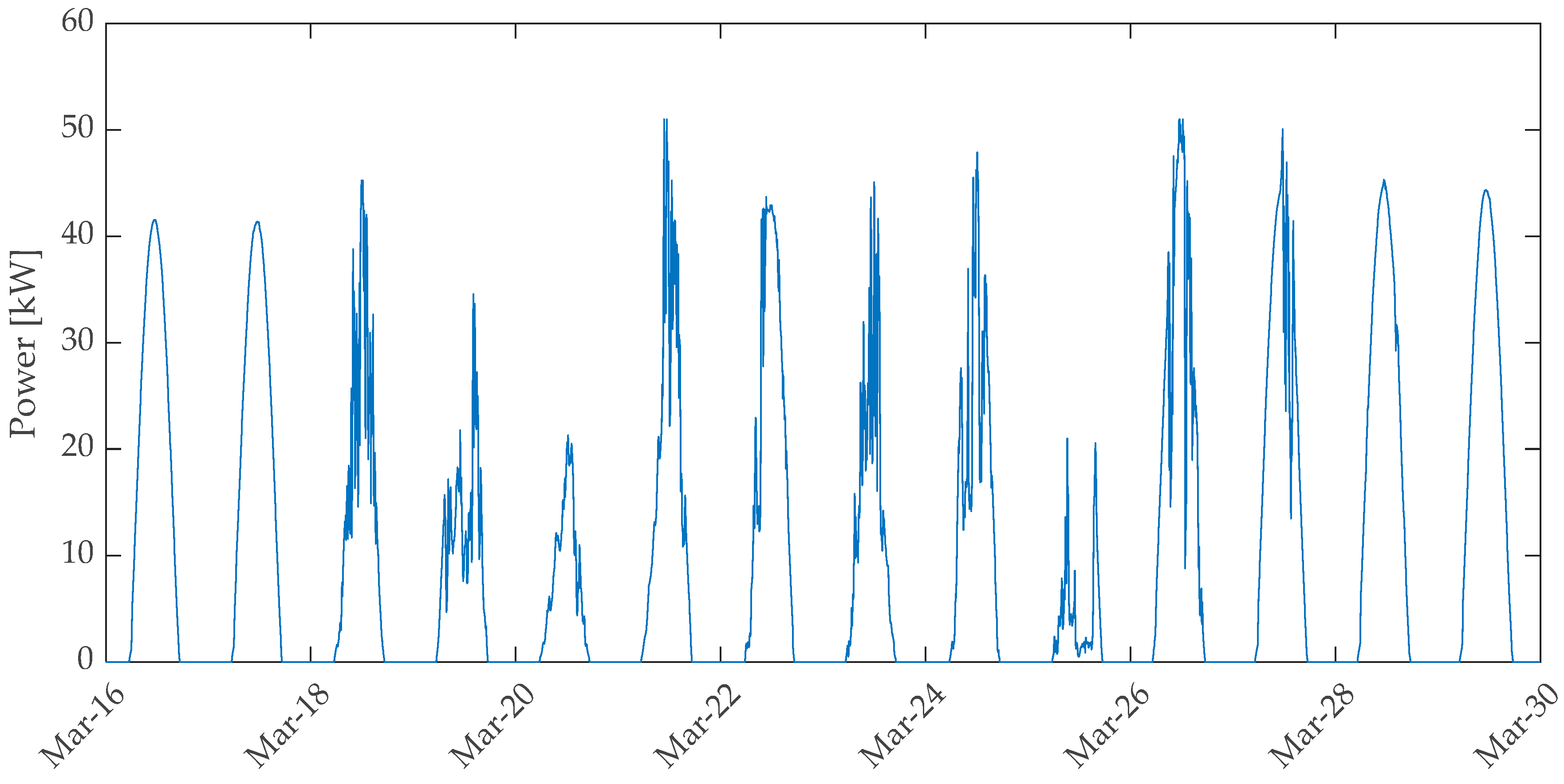

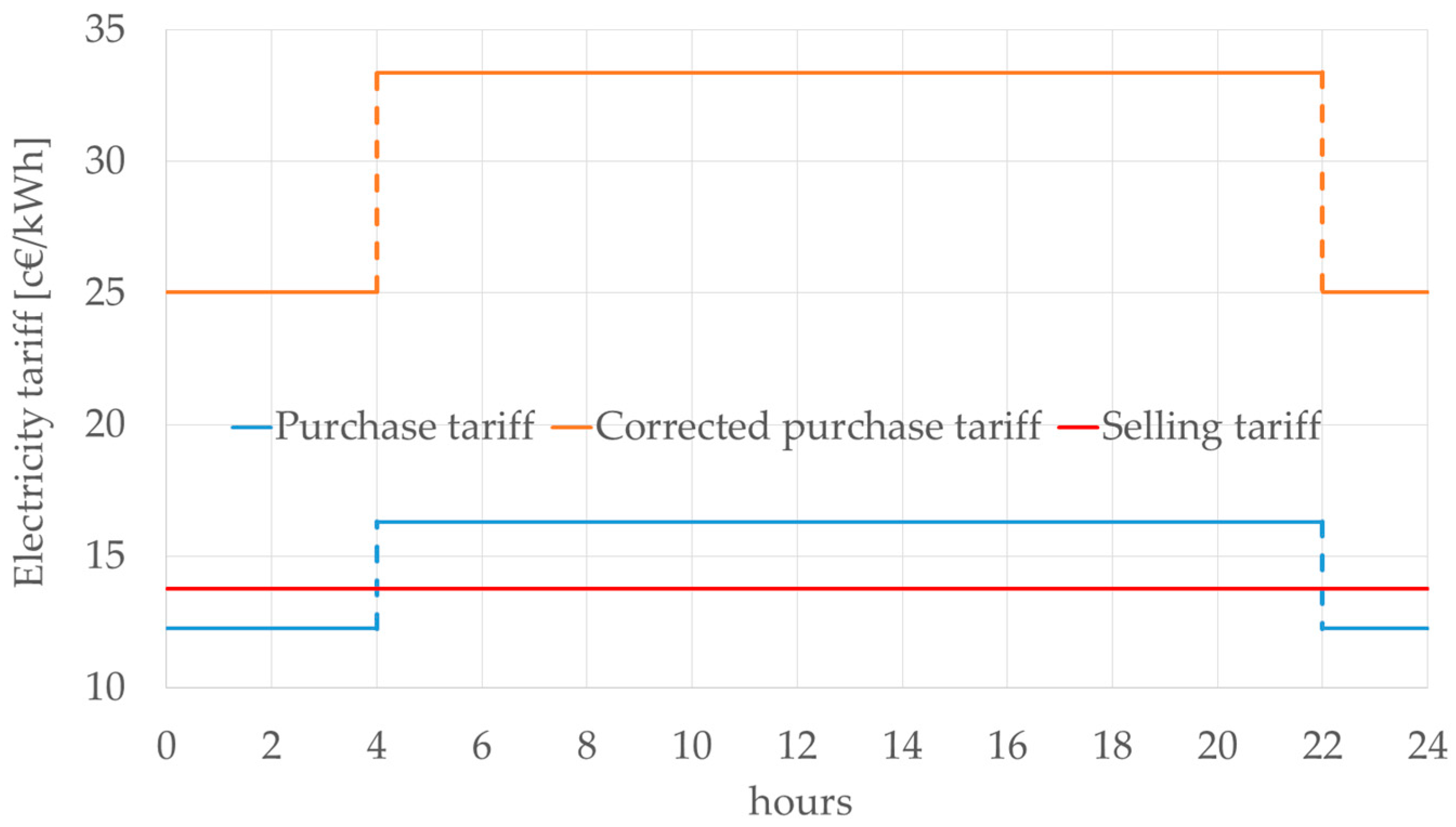
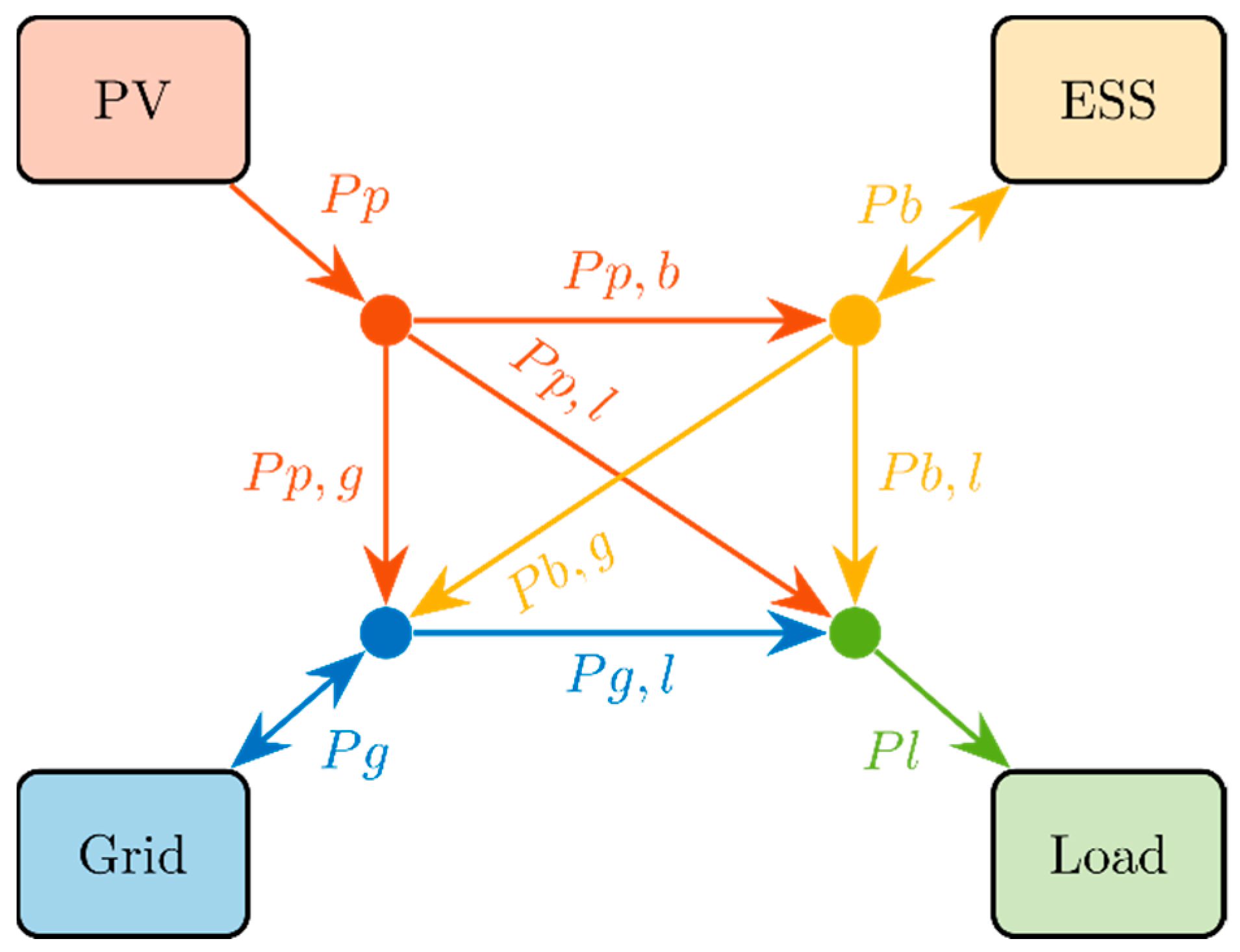
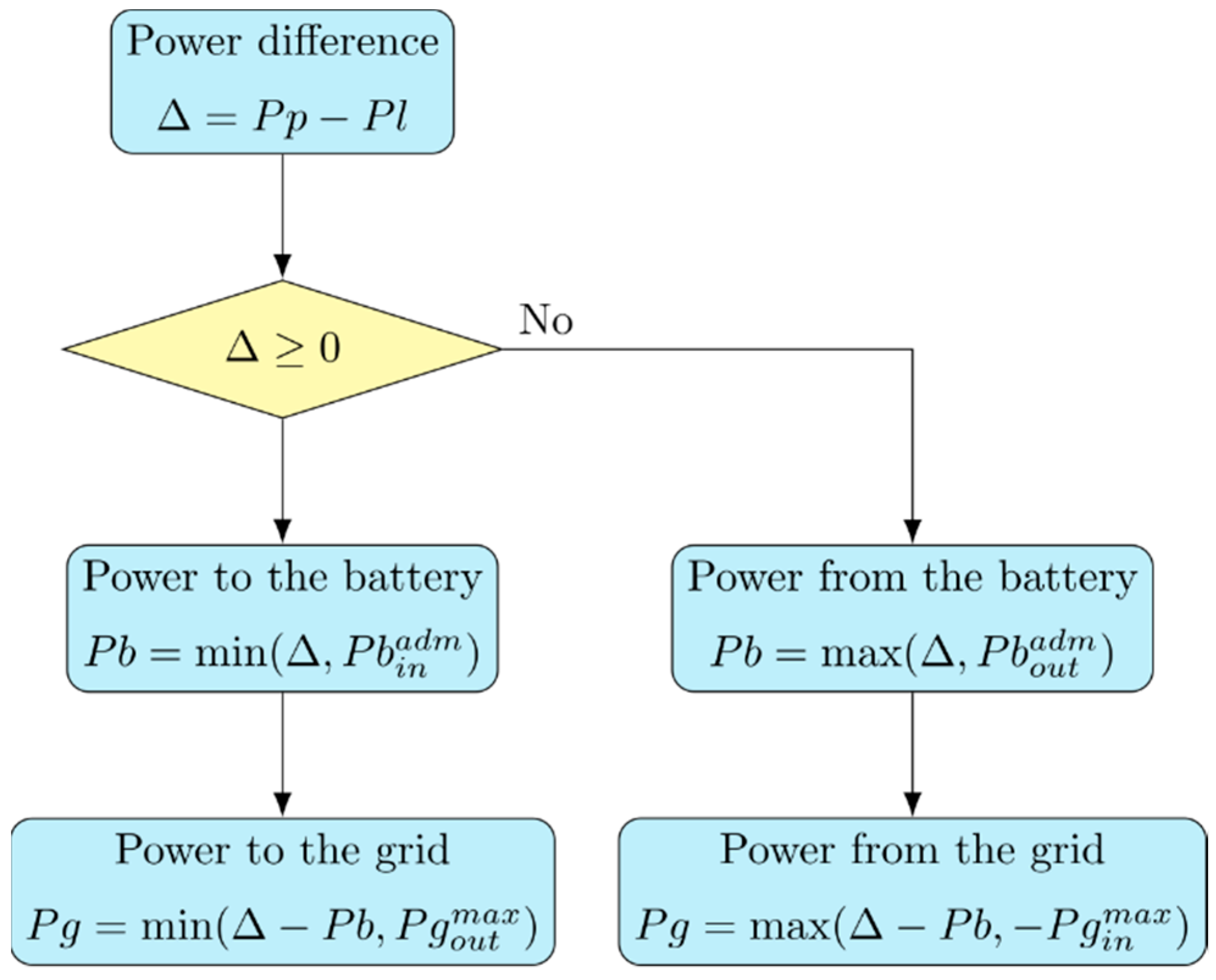


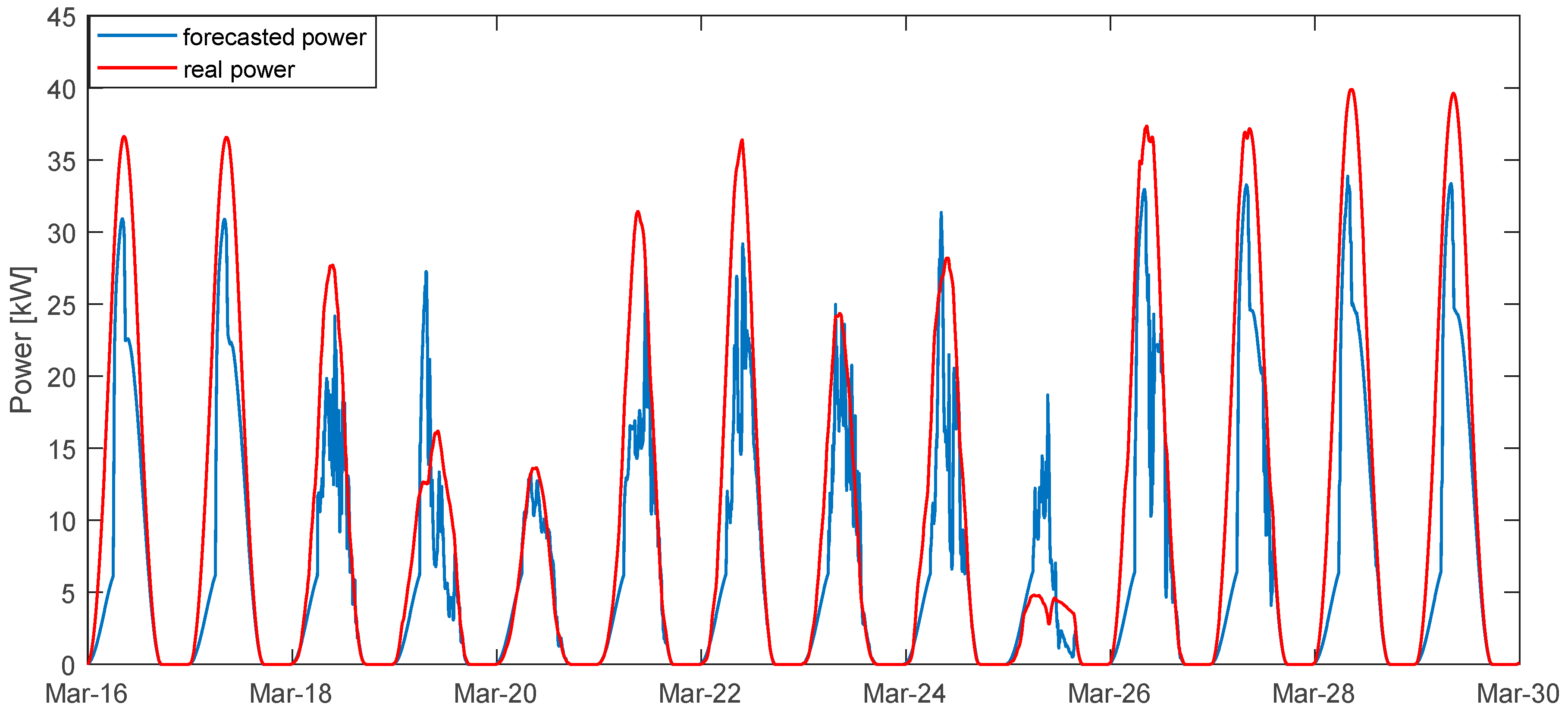
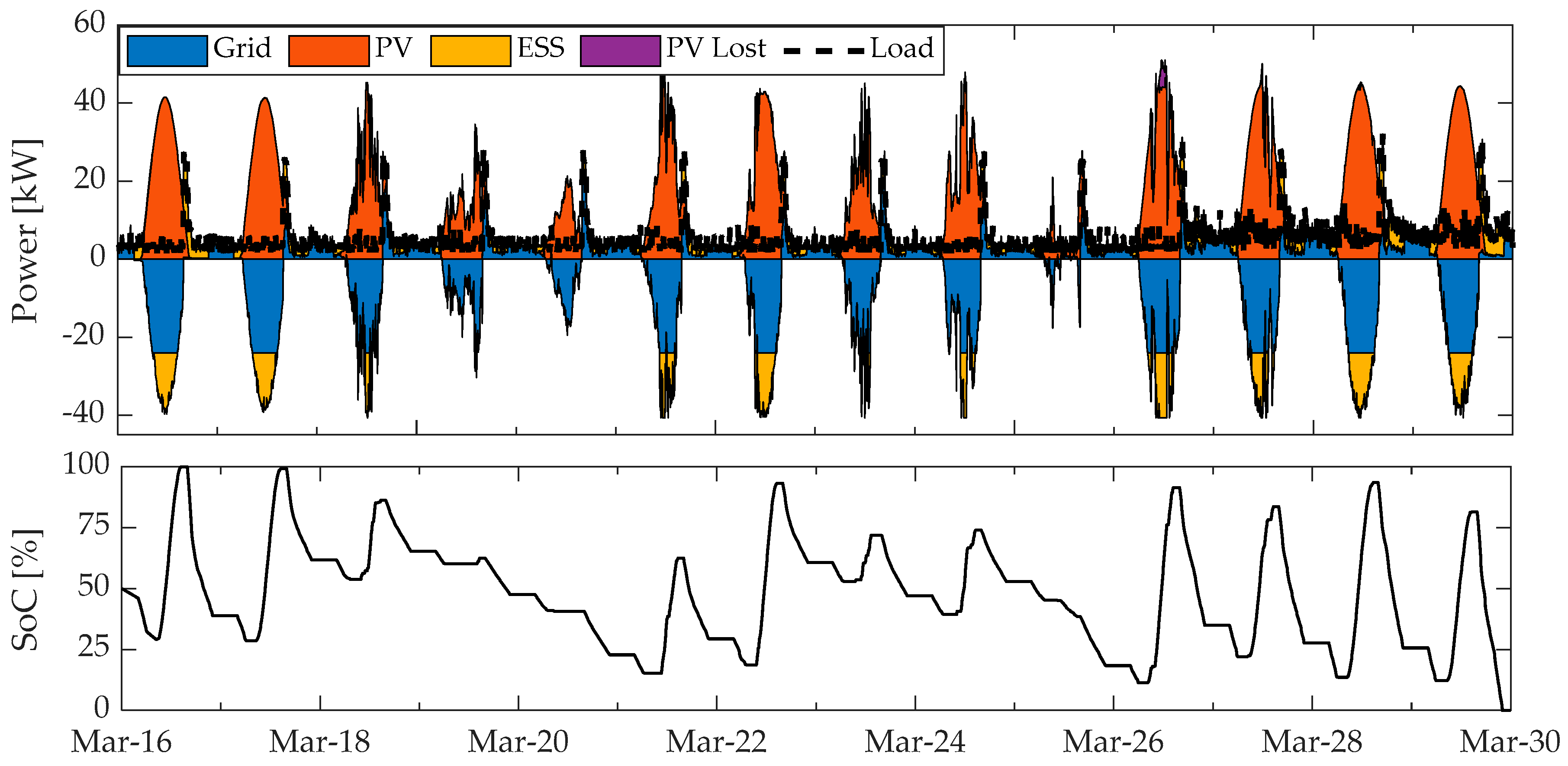
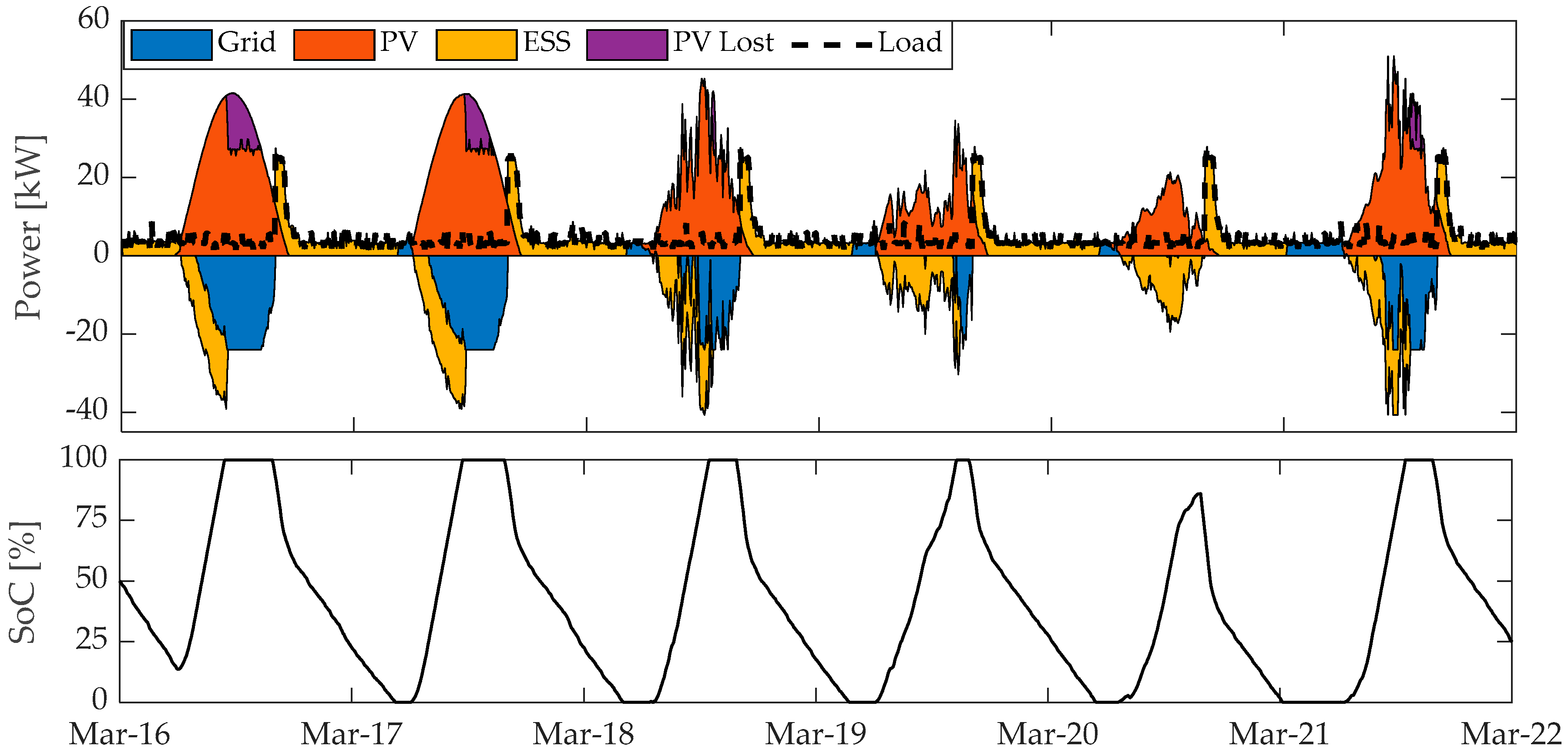
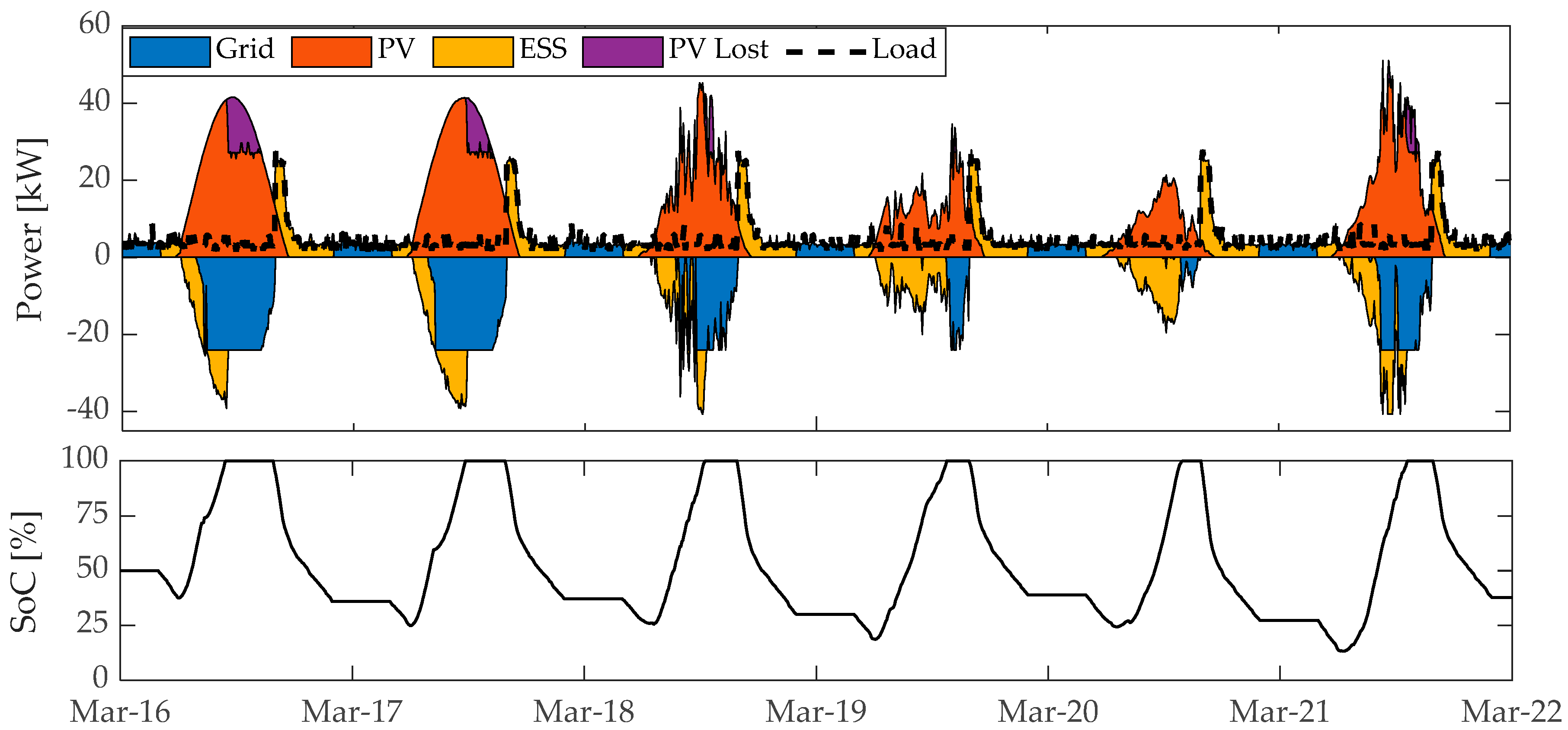
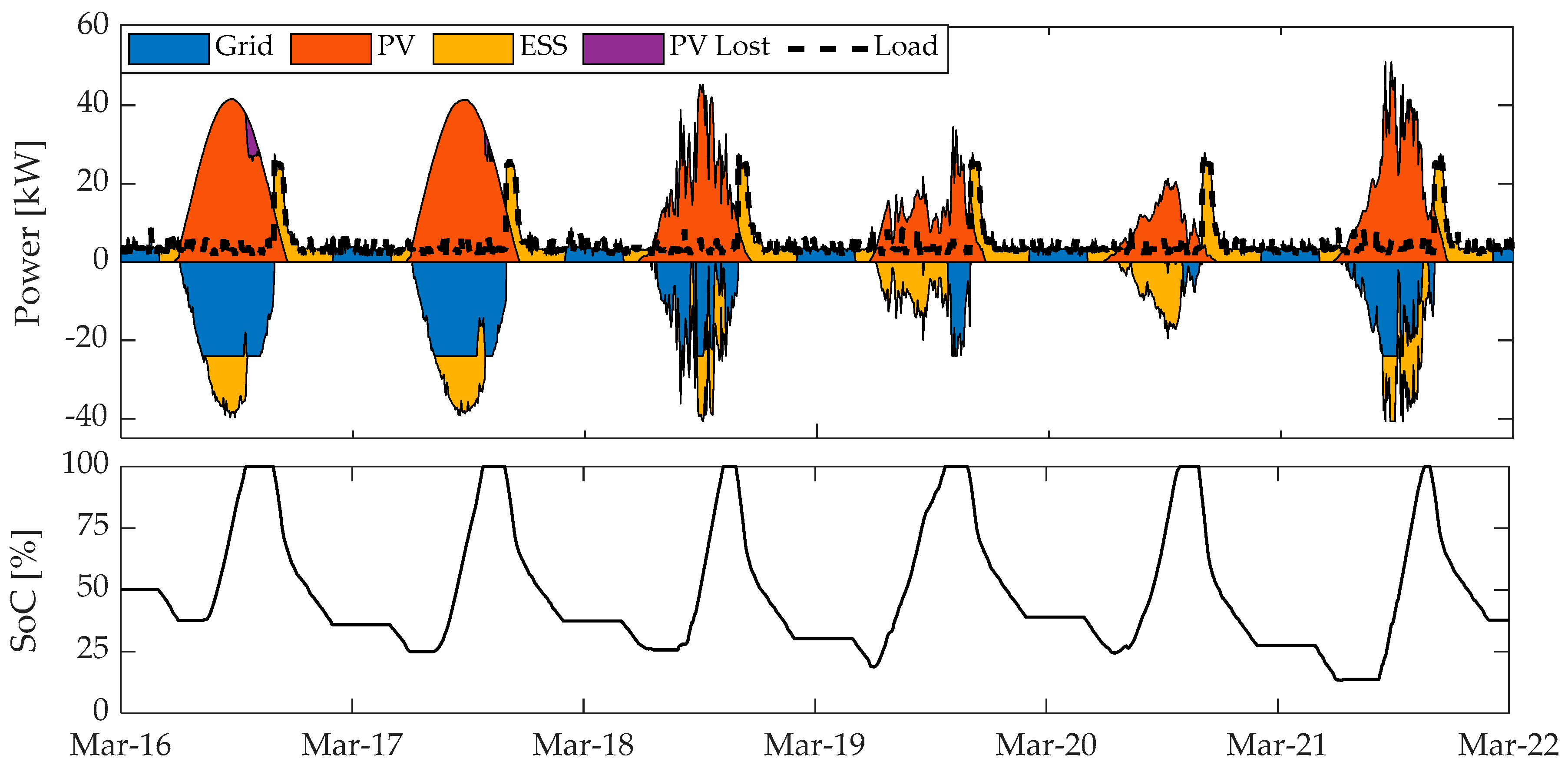
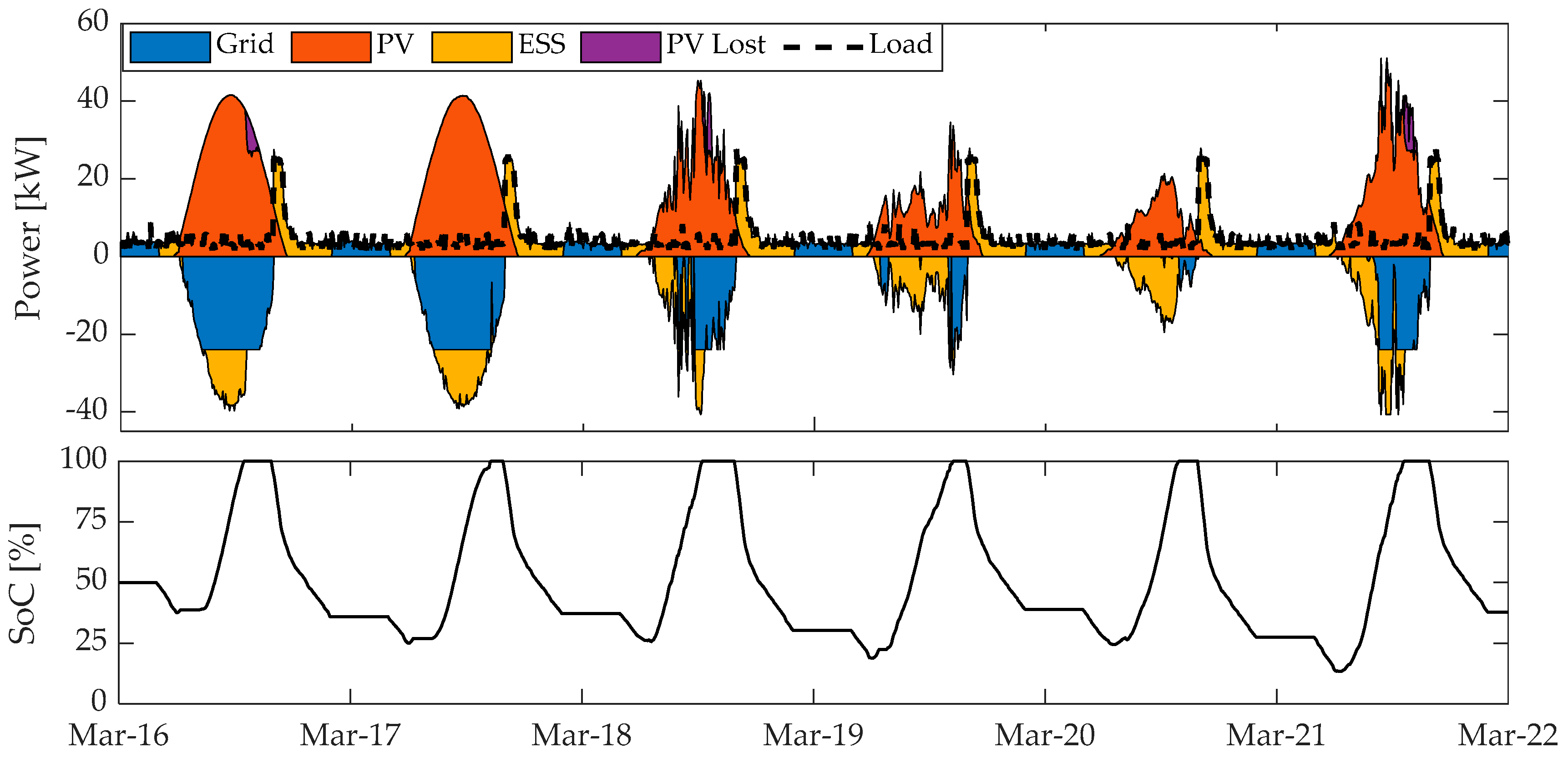

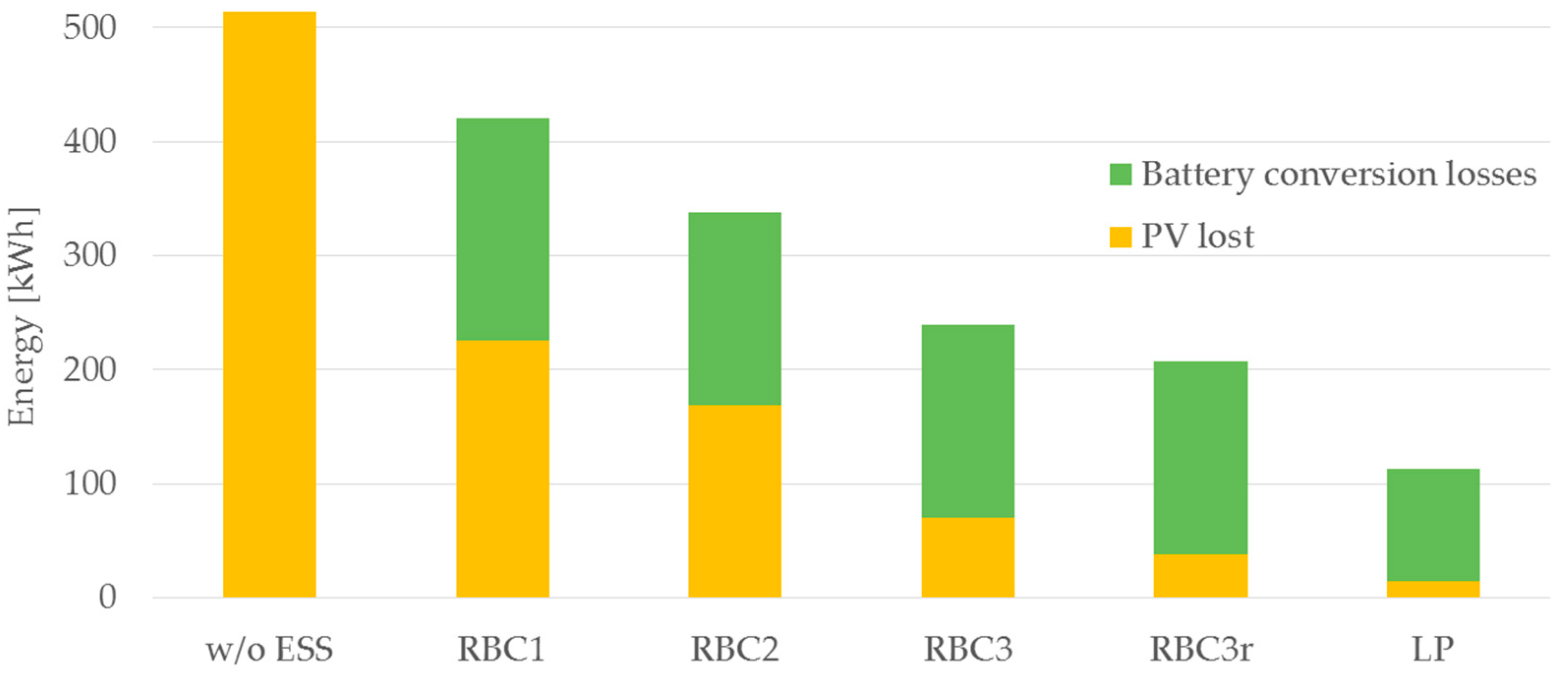
| Parameter | Value | Description |
|---|---|---|
| [kW] | 53 | PV array nominal power (DC) |
| [kW] | 51 | Inverter maximum power (AC) |
| [kW] | 24 | Grid maximum power output (AC) |
| [kW] | 24 | Grid maximum power input (AC) |
| [kWh] | 70 | Battery useful capacity (DC) |
| [kW] | 14 | Battery maximum power input at 0.2 C (DC) |
| [kW] | 35 | Battery maximum power output at 0.5 C (DC) |
| [-] | 0.9 | Battery charge efficiency |
| [-] | 0.9 | Battery discharge efficiency |
| w/o ESS | RBC1 | RBC2 | RBC3 | RBC3r | LP | |
|---|---|---|---|---|---|---|
| Total gain [€] | 120.97 | 152.01 | 168.49 | 182.14 | 186.56 | 191.83 |
| Difference from LP [€] | −70.86 | −39.82 | −23.34 | −9.69 | −5.27 | 0.00 |
| Relative performance | 63.1% | 79.2% | 87.8% | 94.9% | 97.3% | 100% |
| Battery cycles | NA | 13.3 | 11.5 | 11.4 | 11.5 | 6.7 |
| w/o ESS | RBC1 | RBC2 | RBC3 | RBC3r | LP | |
|---|---|---|---|---|---|---|
| Total gain [€] | −56.18 | 111.41 | 116.89 | 130.39 | 134.96 | 147.22 |
| Difference from LP [€] | −203.40 | −35.81 | −30.33 | −16.83 | −12.26 | 0.00 |
| Relative performance | −38.2% | 75.7% | 79.4% | 88.6% | 91.7% | 100% |
| Battery cycles | NA | 13.3 | 11.5 | 11.4 | 11.5 | 13.3 |
© 2020 by the authors. Licensee MDPI, Basel, Switzerland. This article is an open access article distributed under the terms and conditions of the Creative Commons Attribution (CC BY) license (http://creativecommons.org/licenses/by/4.0/).
Share and Cite
Ouédraogo, S.; Faggianelli, G.A.; Pigelet, G.; Duchaud, J.L.; Notton, G. Application of Optimal Energy Management Strategies for a Building Powered by PV/Battery System in Corsica Island. Energies 2020, 13, 4510. https://doi.org/10.3390/en13174510
Ouédraogo S, Faggianelli GA, Pigelet G, Duchaud JL, Notton G. Application of Optimal Energy Management Strategies for a Building Powered by PV/Battery System in Corsica Island. Energies. 2020; 13(17):4510. https://doi.org/10.3390/en13174510
Chicago/Turabian StyleOuédraogo, Sarah, Ghjuvan Antone Faggianelli, Guillaume Pigelet, Jean Laurent Duchaud, and Gilles Notton. 2020. "Application of Optimal Energy Management Strategies for a Building Powered by PV/Battery System in Corsica Island" Energies 13, no. 17: 4510. https://doi.org/10.3390/en13174510
APA StyleOuédraogo, S., Faggianelli, G. A., Pigelet, G., Duchaud, J. L., & Notton, G. (2020). Application of Optimal Energy Management Strategies for a Building Powered by PV/Battery System in Corsica Island. Energies, 13(17), 4510. https://doi.org/10.3390/en13174510







